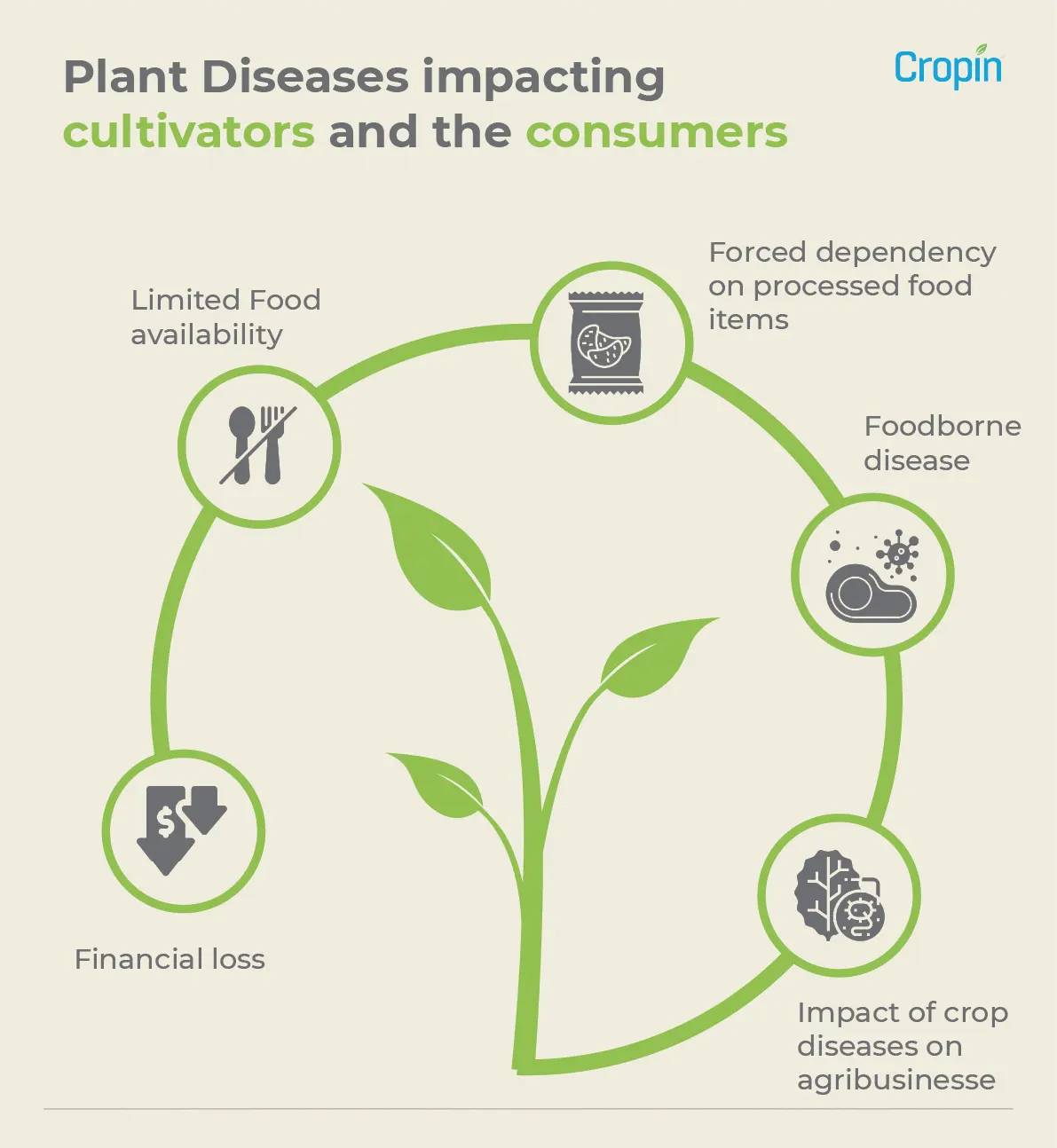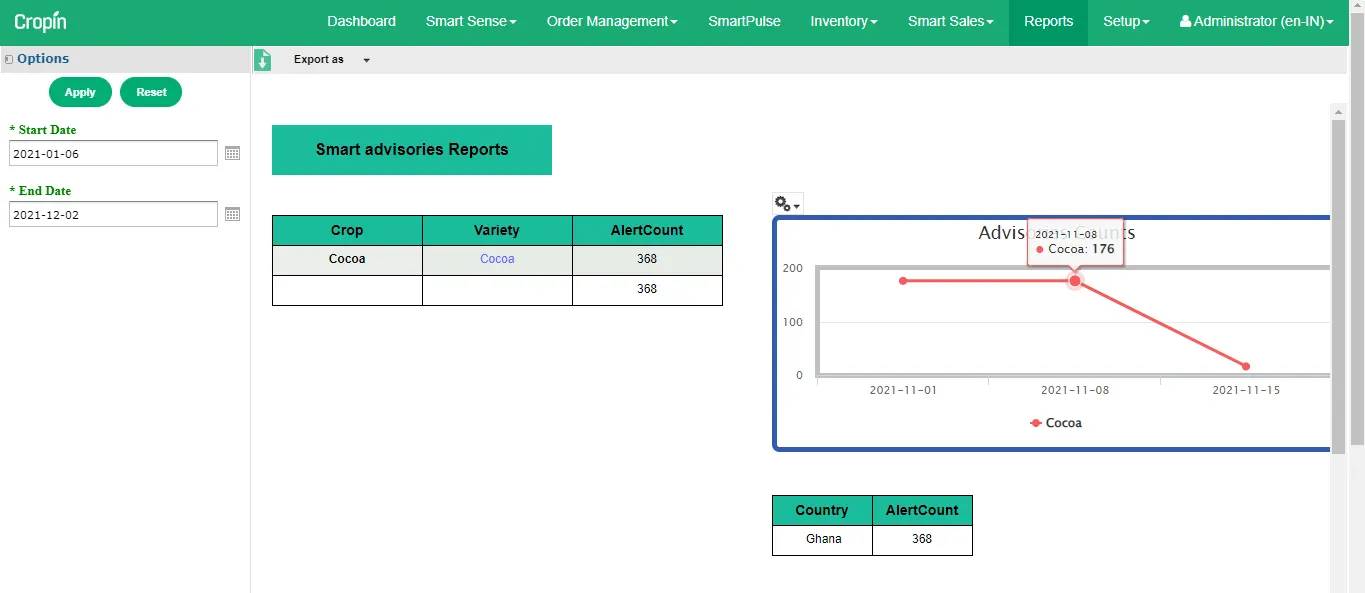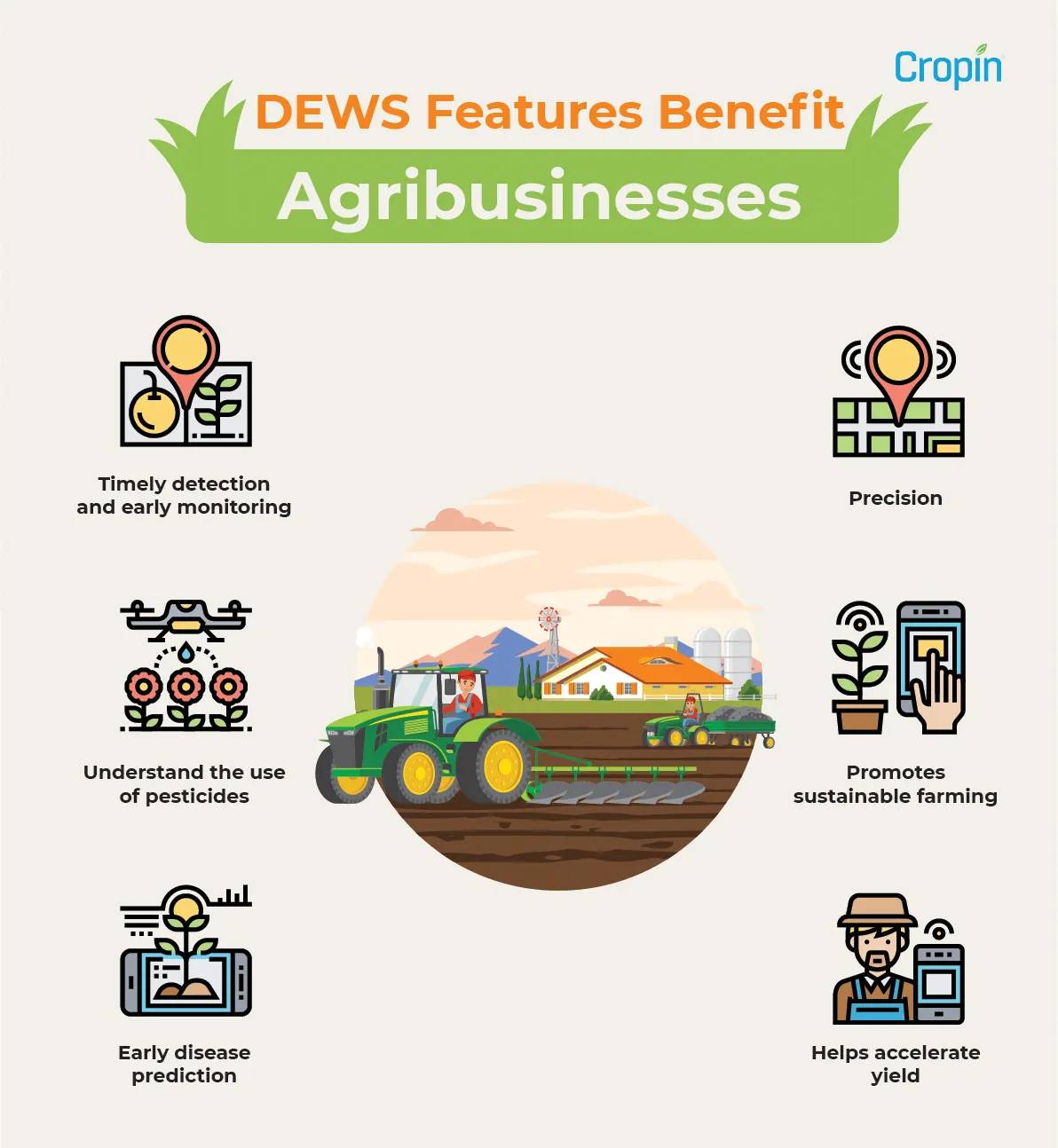A booming population of over 7.8 billion places an increasing demand on resources, one of the most basic and indispensable requirements being food. An ever-rising need for eatables calls for enhanced agricultural output.
However, a rise in crop diseases, many emerging due to climate change and other factors, is one of the leading causes of food insecurity in recent times. Lower yield due to crop infections can also be a headache for farmers and lead to cumulative losses.
Detailed knowledge of these diseases and early detection technologies like Cropin’s DEWS can together help farmers combat such challenges.
Let's see how
Plant diseases and their impact on crop productivity
Like any other disease, plant infections occur when a disease-causing agent interferes with a plant’s natural functioning, growth, or other physiological systems.
Infectious diseases are the result of pathogenic infections. These agents can be parasitic plants, bacteria, viruses, fungi, or nematodes. According to the Food and Agricultural Organization, up to 40% of crops worldwide get wasted due to pests every year. These pathogens spread infection by reproducing inside or on the surface of a host plant and then transmitting it to another vulnerable host.
Mostly, crops are affected by more than one causal agent at a time. For instance, a plant lacking an essential mineral is more susceptible to pathogenic infections. Detailed knowledge of a plant’s natural habitat and other factors can help farmers prevent crop diseases.
However, evolving climate changes can make it difficult for cultivators to predict such diseases based on age-old knowledge alone. This challenge is more so because of the newly discovered correlation between specific microbes and atmospheric pollution. Acid rain, for instance, is a favorable growing condition for the wheat fungus Stagonospora.
A combination of such infectious and non-infectious agents can expedite crop losses due to diseases and can be very difficult to predict without advanced technology.

Effects of plant diseases on farmers’ livelihoods and food security
Here is how crop losses negatively impact both the cultivators and the consumers:
-
Financial loss:
Farmers invest heavily, often in hundreds of billions, in the cultivation of crops. Crop damages result in subsequent losses, directly affecting the cultivators’ livelihoods. The impact is even more prominent in third-world countries where farmers already struggle with inadequate produce. In turn, this results in insufficient investment, leading to a cycle of poor farming practices, un-regularized crop health management, and subsequent crop diseases. -
Limited food availability :
Plants account for the primary source of nutrition for human beings, constituting over 80% of the necessary food items. Therefore, significant yield losses due to crop diseases lower food availability significantly. This low availability of food, in turn, results in maximum deaths due to starvation in third-world countries. -
Food-borne disease :
Besides food scarcity, plant infections can also cause diseases in humans consuming these eatables due to low-quality end-products with altered nutritional value. These affect human beings by producing toxic metabolites. One such example constitutes mycotoxins in maize and peanuts. Fungi, like Penicillium spp. and Aspergillus flavus, produce these mycotoxins that infect plants. Consuming these infected crops, in turn, affect the liver in low doses and can be fatal in high quantities. Similarly, these crop pests can also affect cultivators directly exposed to these agents in the field. -
Forced dependency on processed food items:
Low availability of crops often compels individuals to rely on imported food items. These predominantly comprise processed and ready-to-eat preparations replacing fresh vegetables and fruits. Increasing reliance on such alternatives hinders individuals from maintaining a balanced diet and leads to increased health problems. -
Impact of crop diseases on agribusinesses:
Low yield due to crop diseases adversely affects not only cultivators but agribusinesses, too. Given the pre-existing transportation issues, low produce only adds to the losses that these businesses face.
The primary requirement to bridge the gap between potential and actual crop yields is to implement better technical and digital support. It can help farmers monitor and predict the occurrence of plant diseases better and address them immediately to prevent further deterioration.
Wondering how?
Here is where Cropin offers the perfect solution for cultivators!
Early warning systems and the use of technology: Cropin’s DEWS model
Cropin’s Disease Early Warning System or DEWS model is a weather-based disease prediction technology. As the name suggests, it uses weather forecasts and the history of crop diseases’ previous occurrences to predict their probability.
So, what makes this knowledge-based model so effective in preventing low yield due to plant diseases?
Here are the features that make it stand apart:
- Availability of over 65 disease models, out of which Cropin has already implemented 14;
- Applicable for more than 20 crop variants;
- Crop’s growth stage and the prevailing weather information used along with measurements of relative humidity, total rainfall, rainy days, and maximum, minimum and average temperatures; and
- Predictions delivered monthly or every two weeks, making it easier for cultivators to carry out continuous monitoring.

How will these DEWS features benefit agribusinesses?
Here are the primary advantages that farming companies can avail from this disease forecasting model:
-
Timely detection and early monitoring:
Early detection of crop diseases can help cultivators address them timely, thus preventing low yield due to crop losses. -
Understand the use of pesticides:
The DEWS model also ensures the easy availability of pest control products to curb crop infections. Based on the predictions, farmers can plan their pesticide purchases and only buy what is necessary. -
Early disease prediction:
Predicting disease in advance can help farmers effectively plan efficient control methods and target problem areas specifically. -
Precision agriculture:
Such precise application of disease management products will reduce overuse and excess run-offs of agrochemicals. -
Promotes sustainable farming:
This disease-control model also fosters sustainable agriculture and regenerative agriculture practices that enhance soil quality instead of depleting it. -
Helps accelerate yield:
A higher yield output will lead to better food security for the community and higher economic gains for cultivators.

The DEWS model combined with Cropin’s Cropin Grow (SmartFarm)and SmartRisk can help agribusinesses leverage AI to plan marketing and sales strategy to enhance profit. They can also use the platform’s real-time SMS-based advisory to carry out operations efficiently.
In all, Cropin’s DEWS model is a prime example of how technology can help alleviate all the negative consequences of crop diseases, be it for businesses or consumers.








